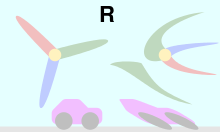Rolling shutter

(click for SMIL animation)
Rolling shutter is a method of image capture in which a still picture (in a still camera) or each frame of a video (in a video camera) is captured not by taking a snapshot of the entire scene at single instant in time but rather by scanning across the scene rapidly, either vertically or horizontally. In other words, not all parts of the image of the scene are recorded at exactly the same instant. (Though, during playback, the entire image of the scene is displayed at once, as if it represents a single instant in time.) This produces predictable distortions of fast-moving objects or rapid flashes of light. This is in contrast with "global shutter" in which the entire frame is captured at the same instant.
The "rolling Shutter" can be either mechanical or electronic.[1][2] The advantage of this method is that the image sensor can continue to gather photons during the acquisition process, thus effectively increasing sensitivity. It is found on many digital still and video cameras using CMOS sensors. The effect is most noticeable when imaging extreme conditions of motion or the fast flashing of light. While some CMOS sensors use a global shutter,[3] the majority found in the consumer market use a rolling shutter.
CCDs (charge-coupled devices) are alternatives to CMOS sensors, which are generally more sensitive and more expensive. CCD-based cameras often use global shutters, which take a snapshot representing a single instant in time and therefore do not suffer from the motion artifacts caused by rolling shutters.[4]
Distortion effects

Rolling shutters can cause such effects as:
- Wobble. This phenomenon (also known as the jello effect) appears when the camera is vibrating, in situations such as hand-held shots at telephoto settings, or when shooting from a moving vehicle. The rolling shutter causes the image to wobble unnaturally.
- Skew. The image bends diagonally in one direction or another as the camera or subject moves from one side to another, exposing different parts of the image at different times. Skew is a minor manifestation of the wobble phenomenon described above.
- Smear. This effect can be easily viewed with a cell phone camera and something rotating quickly, such as a propellor. The smear of each blade is caused by the propeller rotating at the same or near the same speed that the frame is read by the camera. Viewed perpendicular to a fan spinning clockwise, the blades on the left side appear thinner than usual while the blades on the right side appear thicker, and can even appear as if they aren't connected at the center.
- Partial Exposure. If a camera flash goes on for only part of the time of the exposure, the illumination of the flash may only be present for some rows of pixels in a given frame. For example, the top 1/3 of the picture may be brightly lit by a flash, while the bottom 2/3 of the picture is dark and unlit, as the flash was off by the time that part of the CMOS was sequenced. The difference between the two distinct parts of the frame can look odd. Similar problems can arise with fluorescent lighting, strobe effects, lightning, or any extreme situation where very fast motion or very fast bursts of light are seen in the time between when the CMOS chip sequentially records a frame.
- Spatial and temporal aliasing.

The effects of a rolling shutter can prove difficult for visual effects filming. The process of matchmoving establishes perspective in a scene based on a single point in time, however this is difficult with a rolling shutter that provides multiple points in time within the same frame. Final results depend on the readout speed of the sensor and the nature of the scene being filmed; as a rule of thumb, higher end cinema cameras will have faster readout speeds and therefore milder rolling shutter artifacts than low end cameras.
See also
Notes
- ↑ "Electronic shuttering: Rolling vs Global shutter" (PDF). Motionvideoproducts. Retrieved 2011-12-22.
- ↑ Shutter Operations for CCD and CMOS Image Sensors Kodak
- ↑ "TrueSNAP Shutter Freezes Fast-Moving Objects" (PDF). Eric Fossum. 2013-11-13. Retrieved 2013-11-13.
- ↑ "To CCD or to CMOS, That is the Question | B&H Photo Video Pro Audio". Bhphotovideo.com. Retrieved 2010-08-21.
External links
| Wikimedia Commons has media related to Rolling shutter. |
- Airplane propeller blades - rolling shutter effect on YouTube
- Bass strings - rolling shutter effect (vimeo)
- 3D rendering explaining how a rolling shutter produces the strange propeller airplane effect on YouTube